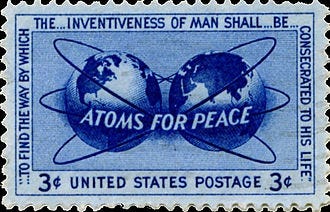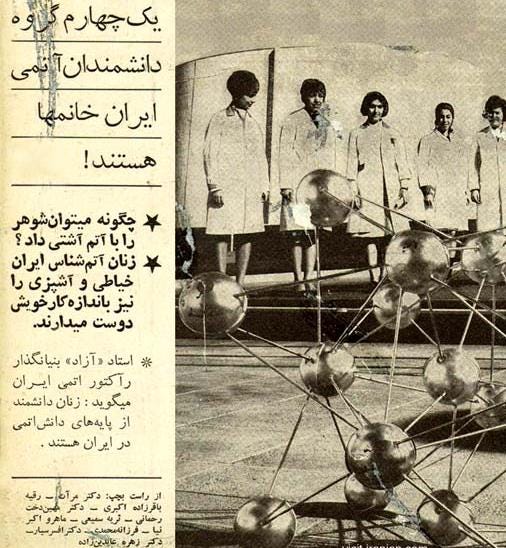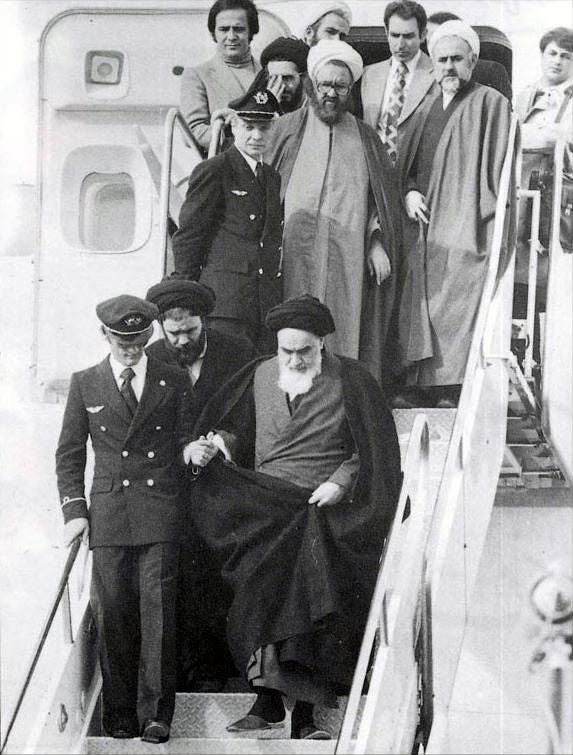50 Years of Fear: The Ongoing Myth of Iran’s Nuclear Bomb
If Tehran really wanted a nuclear bomb, why haven't they bought one?
The Threat of a Nuclear Iran: A Fear Since the 1970s
There was only one reason the US barreled into the Israel-Iran war last weekend: because “Iran cannot be allowed to have a nuclear weapon.”
President Donald Trump utters that sentence every few days — including just before he authorized US forces to drop “bunker busters” on three Iranian sites where enriched uranium — near weapons grade — is, or was, deeply buried.
And that sentiment “Iran cannot be allowed to have a nuclear weapon” is ricocheting across the Western world, becoming a geopolitical mantra echoing from London to Brussels, Canada to Rome yet again.
The weird thing: that idea — no nukes for Iran! — has been chanted by world leaders for 50 years now, and Iran still apparently doesn’t have a nuke. This makes me wonder if a) Iran has the least savvy nuclear engineers in the world or b) if Iran, which maintains its nuclear enrichment activity is only for its nuclear plants, actually even wants one. Because after half a century why wouldn’t the ayatollahs have just bought a bomb from a rogue power, like North Korea, or a dodgy network like A.Q. Khan’s. Is Iran’s credit that bad?
And the fear of a nuclear Iran goes back long before 1979, when Ayatollah Khomeini returned to Iran to kick up an Islamic Revolution and eject the Shah.
The Beginnings of the Iranian Nuclear Bogeyman
The story of the dreaded Iranian nuke starts in the days of the Shah. Because beyond being an autocrat and an ally of the US whose rule was dubiously believed to exert a stabilizing influence on the Middle East, Mohammad Reza Pahlavi was a huge fan of the atom.
Signing up for Eisenhower’s “Atoms for Peace” program, the Shah finally received his nuclear starter kit from the US in 1967 — being gifted a 5-megawatt research reactor powered by highly enriched uranium fuel. Iranian scientists were also offered nuclear engineering courses at MIT.
Eisenhower’s “Atoms for Peace” program gifted similar reactors and highly enriched uranium fuel to 30 countries, including Israel, India, Pakistan, South Korea, South Africa and Taiwan — and all of the above named countries attempted to make nuclear weapons. The first three succeeded and the others were persuaded to drop the idea.
The Shah was ecstatic, soon developing plans to build two dozen nuclear reactors — so Iran could just export its oil and natural gas — and literally becoming the poster child for peaceful nuclear energy.
But the ink was hardly dry on the agreement he’d signed to only employ the reactors for peaceful uses when the Shah began figuring out how to make plutonium and mumbling about Iran just might need nuclear bombs. In June 1974 he even remarked to a journalist that “Iran would have nuclear weapons without a doubt sooner than you think,” a remark he quickly walked back.
But in 1976, noting that other countries (read Israel and India) had developed nuclear weapons (also helped along by reactors from the US “Atoms for Peace” program), the Shah again speculated to a reporter that Iran might be forced to go that route.
That same year, Henry Kissinger met with the Shah, trying to negotiate a deal whereby the US bought back used fuel rods and processed them stateside, but the deal wasn’t sealed.
The Shah’s Downward Descent
Meanwhile the Shah, who was sick with cancer and increasingly paranoid, saw his popularity downward-spiraling with his people. He kept unleashing his secret police SAVAK and armed forces to deal with dissidents and protests. Even though the Shah declared martial law in early September 1978, a demonstration calling for an Islamic government was held the next day. The army opened fire on protesters, killing at least 64 and injuring hundreds. It only inflamed anti-Shah sentiments.
Trying to minimize the protests, the Shah then allowed the return of dissidents, including Ayatollah Khomeini, who’d been fervently stirring up desires for religious rule via popular radio broadcasts while exiled in France and Iraq. The next year, 1979, Khomeini’s supporters overthrew the Shah’s government, and Iran started a repressive Islamic Republic that continues to this day, although it may now be showing cracks.
One key event leading up to the overthrow: student supporters of Khomeini stormed the US embassy in Tehran, on November 4, 1979 — taking 66 Americans, mostly diplomats and civilian personnel, as hostages. While a dozen were released later that month, 52 were kept hostage until January 1981.
Khomeini is Anti-Nuke at First
The good news: Khomeini was entirely against developing nuclear arms for Iran, and the program was mothballed. The bad news: By the end of the devastating Iran-Iraq War (1980-1988), Khomeini wanted to start the program back up.
By then the US was no longer supplying Iran with nuclear materials and know how, but China, Russia, and A.Q. Khan stepped up to help develop Iran’s reactors and enrichment capabilities to produce weapons-grade fuel from nuclear power’s byproducts.
And since the 1980s, warnings have gone out — from security advisers, from Iraq, from Israel, from the CIA — that Iran is only a few years, months, even weeks away from making a nuclear bomb — or five of them, according to one Iranian plan that Israeli intelligence said it uncovered.
Why Iran Can’t Have Nukes (but North Korea can)
The reason that the idea of Iran becoming a nuclear power — along with North Korea, Pakistan, India, Israel, Russia, China, France, the UK and the US — is anathema is that Iran has frequently issued bellicose threats against Israel, calling for its destruction.
Khomeini’s successor Ayatollah Ali Khamenei, for one, called Israel a "cancerous tumor" that "must be eradicated." Former Iranian President Mahmoud Ahmadinejad in 2005 called Israel a “disgraceful blot” that should be “wiped off the face of the earth.” The list of threats goes on. Missiles rolled out for military parades are painted with: “Death to Israel.”
Thus, it’s assumed — particularly by the Israeli government — that should Iran ever get a nuclear weapon, it would annihilate Israel. (Iran has certainly financed neighboring groups — Hezbollah, Hamas, and the Houthis — to attack Israel, but it’s never threatened to nuke Israel.)
According to a recent article in Time, “The United Nations’ nuclear watchdog reported that Iran’s stockpile of 60% enriched uranium—just below weapons-grade—has grown large enough to produce multiple bombs if further enriched. Analysts say Iran could theoretically produce a bomb’s worth of material in as little as a week, and that no other country has that level of uranium without a nuclear weapons program.”
Are Iranians the Worst Nuclear Engineers Ever?
However, it appears, amazingly, after 50 years of allegedly trying to hammer together its own nuclear arms, that the fearful weapons are still not in Iran’s arsenal; after recent strikes, Iran’s slow-motion nuclear program appears to have been further set back. Another factor in delaying the manufacture of nuclear bombs: Israel keeps targeting Iran nuclear scientists. According to a recent article on inkstickmedia.com, Israel strikes killed 14 scientists in the past few weeks, and another ten before that.
The Iran nuclear deal — formally known as the Joint Comprehensive Plan of Action (JCPOA) — briefly hit pause on the bomb panic. Signed in 2015, it forced Iran to mothball centrifuges, slash its enriched uranium stockpile, and submit to international inspections. In exchange, crippling sanctions were lifted. For a while, the threat receded — until President Trump pulled out the U.S. in 2018, and Iran gradually ramped enrichment back up.
But still, thus far, no nuclear weapons.
In the meantime, Israel, which doesn’t formally cop to it, is believed to possess between 90 and 200 nuclear weapons that can be shot off from land, air, and sea, is reportedly trying to assassinate Ayatollah Khamenei, according to its defense minister Israel Katz.
What’s more, Israel is widely believed to keep the “Samson Option” in its back pocket.
That last-ditch nuclear strategy: should Israel face imminent annihilation, it will launch nuclear weapons, taking down Israel's enemies with it.
I Don’t Like Ike’s Plan
Whatever Iran’s nuclear ambitions — and if they’ve been thwarted or not in recent attacks — it’s hard not to view the starting point of this continuing migraine as President Eisenhower’s well-meant, perhaps, but entirely naive attempt to share the peaceful use of the atom with the world. Because wherever the peaceful atom goes, the threat of nuclear weaponry follows.







I heard Jeffrey Sachs say yesterday that he'd just spoken with an Iranian government official who confirmed that they still don't want to build nukes. I've heard this from other sources too. I wish no one had them.
Thanks for this important piece of history, Melissa.
More on Dwight’s ‘Atom’s for Peace’ initiative in the mid-1950’s:
It was a time when the US had been speeding from ~1,000 Nuclear Weapons at the end of the Truman’s Presidency, toward the manufacture of ~20,000 nuclear weapons by the end of the Eisenhower, in the early 1960’s, and JFK’s inauguration address; RUSSIA had only just tested its first Fission Atomic bomb 4 years earlier, after breaking the Nuclear Design Code, and was only then, in 1953, getting ready for its test of its first Thermonuclear Fusion Bomb.
So, Ike’s Atoms for Peace program was both a means as a solution to providing a Nuclear Deterrent(beyond just the US) to Russia in time, but to also demystify the Myth/Facts of how Atomic Energy could also be harvested for Peace.
Lastly, by looking at the later days of the early ColdWar in the late 1950’s, it was no surprise that Eisenhower’s worldview had shifted drastically toward a kind of universal Paranoid World View, as the by the end of that decade, American leadership were not only just dealing with the direct threats of an Bomber-mounted Gravity Delivered Warhead, but rather, with the advent of Russia’s Sputnik’s first circumnavigation, via an orbit of the globe, coupled with the very first set of ICBM Launch trajectories were being developed & tested; Eisenhower’s work ahead would have to envelop the pressing concern of alternate bomb delivery methods—which meant much shorter delivery-times, from the proverbial, seat of his pants—or, that that there was a very quickly emerging new system of Nuclear Warhead Delivery on the near-term side of the horizon of the Western-Hemisphere heading our way which would change the Strategic Initiation of a Nuclear-War Deterrence, and its timetable drastically/immediately.
Interesting to remember, and to note, that in that short period of time, the Eisenhower Administration had to set in motion, a very-highly confidential, accelerated development program for both the unreachable Reconnaissance SR-71 Mach3+ 80,000 ft cruising height to find & accumulate primarily Russian Targets, showing Russian military resource allocation changes; the first Mercury and Pioneer Manned and Unmanned Space Programs, whose targets were presumably acquired in a similar way to the SR-71’s targets, and these Programs were likely being used for more than just surveillance purposes.
So yes, beyond his leadership in WWII, Ike gave a lot of intangible/immeasurable value/effort to the USA, most likely best measured in the shortening, in the years of his remaining life, after leaving office.